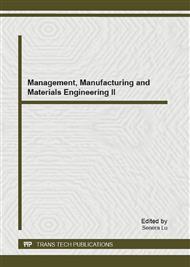[1]
T. Kako and J. Ye: Langmuir Vol. 23(2007), P. (1924).
Google Scholar
[2]
H. Liu, L. Feng, J. Zhai, L. Jiang and D. B. Zhu: Langmuir Vol. 20 (2004), P. 5659.
Google Scholar
[3]
H. S. Lim, J.T. Han, D. Kwak, M. H. Jin and K. Cho: Journal of the American Chemical Society Vol. 128(2006), P. 14458.
Google Scholar
[4]
L. L. Wang, X. T. Zhang, Y. Fu, B. Li and Y. C. Liu: Langmuir Vol. 25 (2009), P. 13619.
Google Scholar
[5]
B. Yan, J. G. Tao, C. Pang, Z. Zheng, Z. X. Shen, C. H. A. Huan and T. Yu: Langmuir Vol. 24(2008), P. 10569.
Google Scholar
[6]
T. Pauporte, G. Bataille, L. Joulaud and F. J. Vermersch: Journal of Physical Chemistry C Vol. 114(2010), P. 194.
Google Scholar
[7]
T. L. Sun, G. J. Wang, H. Liu, L. Feng, L. Jiang and D. B. Zhu: Journal of the American Chemical Society Vol. 125 (2003), P. 14996.
Google Scholar
[8]
S. Sarkara, S. Patraa, S. K. Berab, G. K. Paulc and R. Ghosh: Materials Letters Vol. 64 (2010), P. 460.
Google Scholar
[9]
A. M. Kietzig, S. G. Hatzikiriakos and P. Englezos Langmuir Vol. 25(2009), P. 4821.
Google Scholar
[10]
B. Su, M. Li, Z. Y. Shi and Q. H. Lu: Langmuir Vol. 25 (2009), P. 3640.
Google Scholar
[11]
N. Zhao, J. Xu, Q. D. Xie, L. H. Weng, X. L. Guo, X. L. Zhang and L. H. Shi: Macromol Rapid Commun Vol. 26 (2005), P. 1075.
Google Scholar
[12]
T. S. Cheng, H. T. Lin and M. J. Chuang: Materials Letters Vol. 58 (2004), P. 650.
Google Scholar
[13]
D. A. Wang, Z. G. Guo, Y. M. Chen, J. C. Hao and W. M. Liu: Inorganic Chemistry Vol. 46 (2007), P. 7707.
Google Scholar
[14]
X. M. Liu and J. H. He: Langmuir Vol. 25 (2009), P. 11822.
Google Scholar
[15]
F. Shi, X. X. Chen, L. Y. Wang, J. Niu, J. H. Yu, Z. Q. Wang and X. Zhang: Chemistry of Materials Vol. 17 (2005), P. 6177.
Google Scholar
[16]
Z. G. Guo, F. Zhou, J. C. Hao and W. M. Liu: Journal of the American Chemical Society Vol. 127 (2005), P. 15670.
Google Scholar
[17]
Y. B. Kwon, B. M. Weon, K. H. Won, J. H. Je and Y. Hwu: Margaritondo G. Langmuir Vol. 25 (2009), P. (1927).
DOI: 10.1021/la804081k
Google Scholar
[18]
W. Q. Zhu, J. Zhai, Z. W. Sun and L. Jiang: Journal of Physical Chemistry C Vol. 112 (2008), P. 8338.
Google Scholar
[19]
J. Wu, H. J. Bai, X. B. Zhang, J. J. Xu and H. Y. Chen: Langmuir Vol. 26 (2010), P. 1191.
Google Scholar
[20]
E. Hosono, H. Matsuda, I. Honma, M. Ichihar and H. S. Zhou: Langmuir Vol. 23(2007), P. 7447.
Google Scholar
[21]
Z. G. Li, S. Miyake, M. Makino and Y. X. Wua: Applied Surface Science Vol. 255 (2008), P. 2370.
Google Scholar
[22]
Y. F. Gao, Y. Masuda and K. Koumoto: Langmuir Vol. 20 (2004), P. 3188.
Google Scholar


